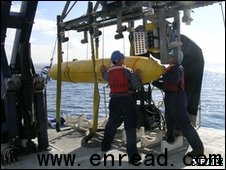| ||||||||||||||||||||||||||||||||||||||||
|
scientists in the us are using an underwater vehicle that can "plan its own experiments" on the seafloor. 美国科学家使用一种新型的、“可自行设计实验”的水下机器人在海底进行科学研究。  it goes, it comes back, the data is downloaded the "gulper auv" is programmed to look for the information that scientists want and plan its own route, avoiding 1(危险的) currents and obstacles. the research team described this advance at the ocean sciences meeting in portland. the group explained how it could "train" the robot to bring the best science back to the surface. thom maughan from the monterey bay 2 research institute (mbari蒙特雷湾水族馆研究所) in california was one of the engineers on the project. he explained how the automatic underwater vehicle (auv) used a piece of software called "t rex", which operates in a similar way to the software used to control nasa's mars exploration rovers - 3 them to avoid obstacles on the surface of the red planet. one main difference between the two pieces of software is that for the mars rovers, the software ran in the control centre on earth. with this 4 vehicle, it runs onboard the robotic vehicle. "you can tell it what to do before you put it in the water," dr maughan said. "we tell it, 'here's the range of tasks that we want you to perform', and it goes off and assesses(评定,估价) what is happening in the ocean, making decisions about how much of the range it will cover to get back the data we want." researchers at mbari used the gulper auv to monitor potentially harmful algal blooms(藻花) . kim fulton-bennett from mbari explained: "we used to send out a ship for a full day every few weeks to manually take these measurements. now we just take the auv outside the harbour and send it on its way. "about 24 hours later, it comes back, we 5(升起,吊起) it on board, and download the data." 点击  收听单词发音 收听单词发音
|
||||||||||||||||||||||||||||||||||||||||
上一篇: 下一篇: |
||||||||||||||||||||||||||||||||||||||||
- 发表评论
-
- 最新评论

